Those that have watched the original BBC mini-series THE HOUSE OF CARDS ( see Pras on World Films: HOUSE OF CARDS / To Play The King / The Final Cut ) will 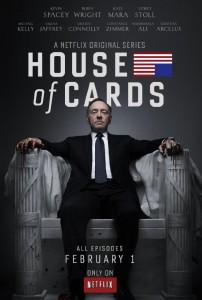 recall the high bar the original one sets for this highly-anticipated talent rich adaptation produced by Netflix. I am part of the general population sample that Netflix predicted will be so engaged with the plot and storyline so as to be tempted to engage in binge-viewing of this television series (and I actually did !). Nevertheless, this Kevin Spacey starrer has done a reasonably good job translating the broad concept from a 1990′s British series from BBC (and the classy performances by it’s lead actors, most notably its wonderfully talented actor, the late Ian Richardson playing Francis Furquhart, the Conservative Chief Whip in the British Parliament’s House of Commons), to an entirely new setting amongst a very recent contemporary American political scene on Capitol Hill.
recall the high bar the original one sets for this highly-anticipated talent rich adaptation produced by Netflix. I am part of the general population sample that Netflix predicted will be so engaged with the plot and storyline so as to be tempted to engage in binge-viewing of this television series (and I actually did !). Nevertheless, this Kevin Spacey starrer has done a reasonably good job translating the broad concept from a 1990′s British series from BBC (and the classy performances by it’s lead actors, most notably its wonderfully talented actor, the late Ian Richardson playing Francis Furquhart, the Conservative Chief Whip in the British Parliament’s House of Commons), to an entirely new setting amongst a very recent contemporary American political scene on Capitol Hill.
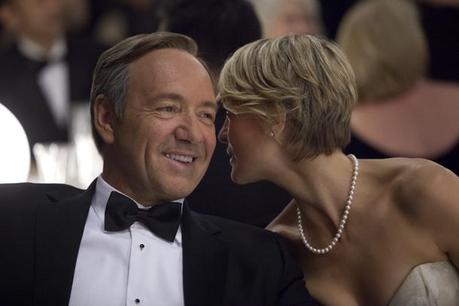
Its also worth noting how writer Aaron Sorkin (“Social Network”) managed to smartly dumb down a complex story about power & intrigue in the British Parliament into a similarly engaging story set on Capitol Hill targeted for an American audience. This wicked political drama penetrates the shadowy world of greed, sex, and corruption in modern D.C. Kate Mara (“American Horror Story”) and Corey Stoll (“Midnight in Paris”) costar in the first original series from David Fincher (“The Social Network”) and Beau Willimon (“The Ides of March”).
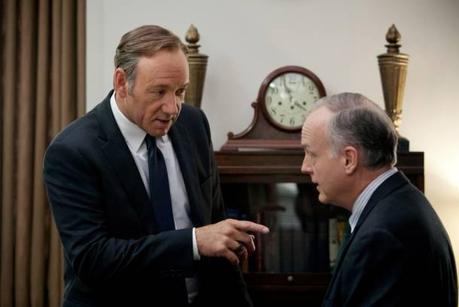
Based off both the novel and the BBC miniseries of the same name, House of Cards stars Kevin Spacey as Francis Underwood, the House Majority Whip and Congressman from South Carolina who plots to take over as Vice President after being snubbed during the selection of Secretary of State. His wife Claire (Robin Wright) runs a non-profit organization that entangles her in the unscrupulous dealings of Washington. Ruthless and cunning, Congressman Underwood (Oscar® winner Kevin Spacey) and his wife Claire (Robin Wright) stop at nothing to conquer everything.
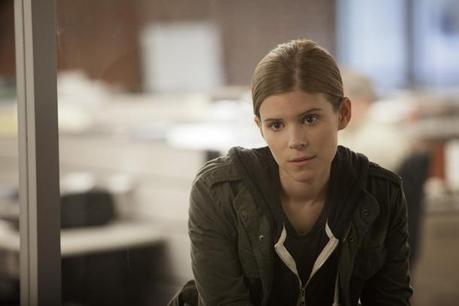
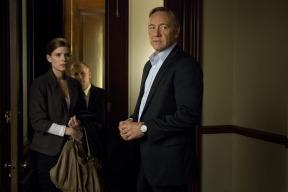
The new “House of Cards” is set in Washington, D.C., in the current day. It finds Spacey as U.S. Congressman Francis Underwood, a shrewd country boy from South Carolina who, early on, describes himself as “just a lowly House majority whip (whose) job is to clear the pipes and keep the sludge moving.” His is a somewhat different self-appraisal than that of Richardson’s Francis Urquhart, the Conservative Chief Whip in the House of Commons, an avuncular aristocrat who wields a silver tongue, a twinkle in the eye and a bloodthirsty streak. With equally false modesty but far more polish, he describes himself as “merely a functionary. I keep the troops in line. I put a bit of stick about.”
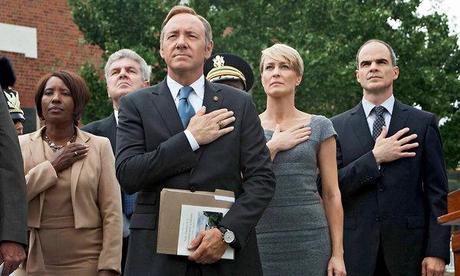
Like the original, the new “Cards” has its particular Francis soon joining forces with a young, hungry and attractive journalist (Kate Mara) in a partnership of subterfuge and mutual convenience that quickly gets personal. And he, too, has a strong and supportive helpmate, his wife Claire (played by Robin Wright) whom he loves “more than a shark loves blood.”
OBSERVATION: Once or twice, Underwood echoes Francis Urquhart’s (from the BBC series )coy not-quite confirmation, “You might very well think that, but I couldn’t possibly comment.” Then, thankfully, he lays it to rest.
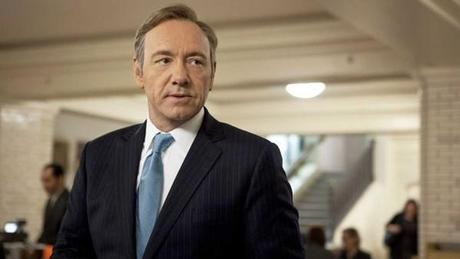
While the original “House of Cards” is irresistible (and available available on Netflix), this “Cards” is an original too. In contrast to the starchy, Thatcher-era government its forebear makes sport of, this “Cards” is waist-deep in today’s Beltway melt-down, where Congress is “choked by pettiness and lassitude,” as Underwood notes in one of his asides to the viewer. Underwood (who, in contrast to the right-wing Urquhart, is some semblance of a liberal Democrat) has his eye on a loftier perch than the House, and there seems no limit to the cunning he can muster toward that goal. Confident but ever-mindful that things can always go awry, he relies on no grand plan but, instead, a thicket of potential counter strikes. His is a meticulously orchestrated power grab. The result is a dark, hard-edged thriller whose soundtrack – far from the proud brassiness of the British “Cards” – is a thrumming, cautionary bass line.
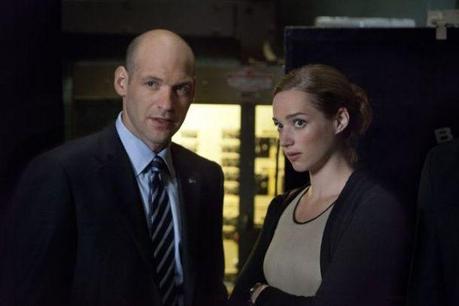
One interesting side-story that reinforced Frank Underwood’s character is that of Congressman Pete Russo played by Corey Stall (he played Hemingway in “Midnight in Paris”, if you recall). Russo’s story is the one that’ll lingers and is almost unbearably sad. 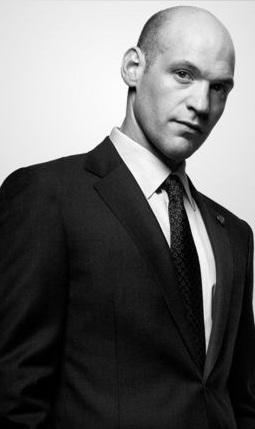
The implication that Frank sought Russo out because he knew he’d self-destruct and ultimately set Frank on the path toward the vice-presidency is truly chilling. But then, the most powerful people are often supreme narcissists, adept at mind-effing even smart men and women. Frank relearns this lesson while dealing with president’s supposed VP pick, billionaire Raymond Tusk (the great Gerald McRaney, channeling his George Heast from Deadwood). Tusk treats him like an errand boy, then comes on like an arrogant usurper, then reveals that he and the prez schooled him as thoroughly as Frank schools everybody else, and that they’re about to hand Frank the prize he fought so hard for, as if it were a Christmas present. Generosity is its own form of power.

The intense style of this “House of Cards” reflects the pair who developed it: Beau Willimon, the Oscar-nominated screenwriter of another political drama, “The Ides of March,” and David Fincher, Oscar-nominated for directing “The Social Network,” a thriller in its own geeky right. Spacey – once he and the audience get used to his Southern accent – is arresting. As a politician on the make, he is evocatively deadpan and sad-eyed, as if he wished this wretched world didn’t justify his deeds but will damn sure make the best of it.
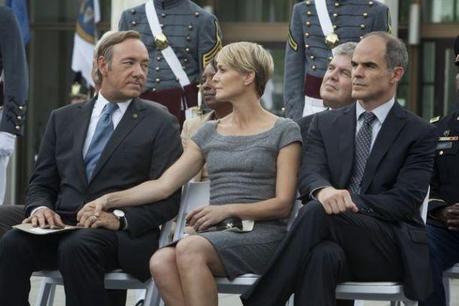
Is House of Cards a realistic portrayal of the political process? It’s no more realistic than, say, The West Wing or The American President, but documentary realism isn’t probably what the series is aiming for. Its real strength is its byzantine plots that express humanity’s unquenchable hunger for more power, and domestic stories that show the impact of those plots on marriage and family. The tactical and emotional tug of war between Frank and Claire, for instance, seems at once completely mercenary and oddly, sincerely affectionate. Claire is revealed primarily via subtext, and a focus on her gestures and actions – both small and large. We come to know and understand her as much as she allows inner world to be revealed to anyone, including herself. Wright’s depiction of this inscrutable woman is finely tuned, and impossible to turn away from.
House of Cards’ finest quality is its unhurriedness. It takes its time introducing the main characters and setting up its plots. Then, once we’re in the thick of it (as it were), it has the courage to let moments breathe and to be okay with lingering on uncomfortable silences and letting important moments play out in a wide shot rather than in a tight close-up (TV’s default mode). The show doesn’t seem terribly concerned with hooking you into watching the next episode, either — probably because the storytellers know that if you’re watching House of Cards, it means you have Netflix, and the next installment is a click away.
The series does present a slightly fantastical picture when it comes to the actual day-to-day grind of online media, painted with broad brush-strokes. Online verses traditional journalism is no longer the hot topic debate it was 15-years ago, the lines have inevitably and irrevocably blurred.
However, it was also interesting to House of Cards’ ability to weave social media into the fabric of the story and make it dramatic, by showing people pausing before texting a reply to somebody, deliberately not picking up a call and listening to the message moments later, or finding words to make dishonesty sound principled in an e-mail (as Cory Stoll’s pathetic, doomed Peter Russo fails to do in an e-mail to a constituent outraged about his silence in the port shutdown). The show’s sophistication about technology seems appropriate with its nature as a Netflix original. The story is also set in a 2013 social context, in which a congressman’s meltdown during a CNN debate can be turned into an AutoTuned YouTube dance track mere hours later.
THE FOURTH WALL IN THEATER & FILM: The audience is the show’s most interesting character. Who is Frank talking to, and what does that make us? One of the most notable stylistic choices is Spacey’s frequent direct to camera address. House of Cards, like the 1990 British BBC miniseries that it was adapted from. The first time Frank Underwood speaks to the audience in House of Cards, it’s not exactly clear whether he’s addressing us or just thinking aloud. Frank is actually talking to us; he stops being coy about it and looks straight at the camera. Breaking the fourth wall is typically associated with Shakespeare — and that comparison grows stronger as the season progresses. Shakespeare often utilized soliloquies to deliver the character’s inner monologues, to let us know what they were thinking, feeling and plotting. Soliloquies were his means to progress the plot, and have the characters deliver commentary on the world that surrounded them. The device serves multiple functions here as well. Underwood will often reveal aspects of his inner emotional life and history, or that of the characters he has been interacting with his address. The asides are also utilized to reveal the finer details of his schemes.
THE MOST CREATIVE SHOT IN HOUSE OF CARDS COMES IN EPISODE 13: Frank is in his office, waiting for the president to conclude a meeting that will determine if his master plan has succeeded. He looks up at the clock above his desk; the camera — the audience — is perched inside the clock as the second hand ticks forward. Frank tells us that waiting is agony, and from our unusual perspective, we can see that he’s been reading The Passage of Power, the fourth installment of Robert Caro’s biography of Lyndon B. Johnson, which was released last year. That’s a pretty loaded product placement. Johnson was a southern politician, known for his skill at manipulation, who became the most powerful man in Congress. The Passage of Power documents Johnson’s ascent to the vice presidency and, following the assassination of John F. Kennedy, the Oval Office.
Cast

Rep. Frank Underwood

Claire Underwood

Zoe Barnes

Rep. Patrick Russo

Christina Gallagher

Linda Vasquez

Lucas Goodwin

Janine Skorsky

President Garrett Walker

Gillian Cole

Sen. Catherine Durant

Remy Danton

Doug Stamper

Adam Galloway

Jim Matthews

Tom Hammerschmidt
Credits
Kevin Spacey: Executive Producer David Fincher: Executive Producer
Andrew Davies: Executive Producer Eric Roth: Executive Producer
Michael Dobbs: Executive Producer Joshua Donen: Executive Producer
John Melfi: Executive Producer Dana Brunetti: Executive Producer
Beau Willimon: Executive Producer Michael Dobbs: Author
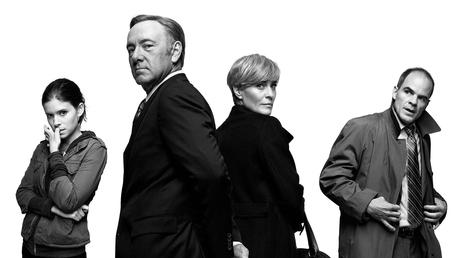
COMMENTARY ON NETFLIX’S RELEASE STRATEGY FOR HOUSE OF CARDS: House of Cards carries no advertising, no commercial breaks. Without advertising, there is less need to spread episodes out over time. Without advertising, there is less pressure to regularize audience attention.
Netflix’s simultaneous release of all the episodes of House of Cards has generated commentary on binge viewing, social TV, the definition of “hit” TV (and here), and business models (and here). Netflix is disregarding conventional audience management strategies, particularly the sequential release of one episode per week. For the past 80 years of commercial broadcasting, the weekly release of episodes served at least two purposes: to fill airtime economically by spreading narratives out over time, and, most important, to secure audience attention for advertisers on a regular basis.
Netflix has the freedom to release all episodes at once because Netflix is not in the business of organizing audience attention for advertising messages. That means Netflix does not have to regularize that attention through scheduling or measure that attention through ratings. Linear commercial television manages “audience flow” with scheduling strategies designed to deliver certain targeted audiences to certain advertisers, as measured by ratings services. Viewers may believe television networks serve them; however, television networks’ primary customers are advertisers, and programs are a means of delivering audiences to those advertisers. Netflix’s customers, on the other hand, are not advertisers, but viewers. What advertisers prefer, a regular schedule that guarantees the weekly exposure of their products, need not shape the preferences of such viewers.
Why doesn’t Netflix schedule like HBO, then? HBO, a commercial-free premium subscription service, creates artificial scarcity by withholding already produced episodes, doling them out week by week. HBO began as a linear service designed to attract subscribers to cable services; its strategies are thus designed to build subscriber loyalty to itself and to cable operators; its announcements of audience ratings serve only to market its brand, not to measure audiences delivered to advertisers. Many observers assume that Netflix is evolving like HBO, shifting from a program buyer to program producer to ensure subscriber loyalty. However, Netflix offers something HBO cannot: asynchronous viewing of a deep catalog of programming. Although HBO offers HBO Go, that service is limited to cable subscribers and to HBO programming. Since asynchronous viewing is what Netflix can offer more cheaply and efficiently than HBO, Netflix needs to distinguish itself from HBO precisely on that basis to attract and retain subscribers. Hence, rather than weekly releases, episode by episode, Netflix has always offered audiences total control over their viewing schedule.
Some find it difficult to grasp how the seriality of House of Cards can work if all episodes are available at once. Seriality as a narrative strategy has been around at least since the Odyssey followed the Iliad, but in the modern era it has also functioned to ensure the maintenance of a revenue stream. Serialized novels enticed readers to buy the next issue of a magazine; serialized films tempted viewers to buy another ticket the next week; and serialized comic strips encouraged readers to buy a newspaper daily. By the early 1930s serialized radio dramas helped ensure that audiences would tune in daily to their “soap opera” and the soap advertisers’ messages. More recently, serials such as The Sopranos helped build HBO subscribers’ loyalty.
Why, then, create House of Cards as a serial at all, if Netflix does not need to tempt audiences into repeated scheduled viewings? Probably because open-ended episode structure is still one of the best ways to encourage viewing of more than one episode. Increased viewership overall would help amortize the show’s high production cost–not because Netflix earns revenue on how many viewers see each episode but because viewer engagement will likely lead to more subscriptions to the service.
Netflix’s willingness to give the audience control over serial viewing challenges assumptions that the best way to control program costs is to eke out episodes over time, measuring demand, and then raising and lowering prices in response. Netflix will track viewership, not to adjust airtime prices for advertisers but to measure subscriber demand and, it hopes, an increase of subscribers. Like HBO’s move into original programming, Netflix’s strategy is risky, but it is designed to attract subscribers to its streaming service–not necessarily to a particular program. No doubt audience control of the pace of narrative consumption will affect social media conversations. But this strategy also challenges the necessity of synchronous viewing as a business model, a model based on the limitations of legacy technologies rather than on some inherent quality of seriality.
Netflix’s current business model also depends on the survival of advertising-supported networks, which are selling programming to Netflix as a new aftermarket. Thus, Netflix is not aiming to destroy linear ad-supported programming. Advertising revenue subsidizes far more programming than Netflix can currently plan to produce on its own. Instead, by offering a new profitable aftermarket for programming initially financed through advertising revenue, Netflix may become commercial television’s white knight. Netflix’s ability to expand offerings of commercial television programming will depend in part on its ability to keep attracting new subscribers. Offering viewers the option to binge, or watch multiple episodes in a sitting, or watch them over a longer time frame, may be Netflix’s best bet for attracting new subscribers.
The full significance of House of Cards, as an indicator of new business models and evolving cultural forms, is yet to be determined. Is it too much to hope that Netflix’s simultaneous release of a season’s worth of premiere episodes is a harbinger of unprecedented audience leverage in an industry too long accustomed to bottleneck control over audiences?
MORE ON NETFLIX’S RELEASE STRATEGY FOR HOUSE OF CARDS: Netflix’s simultaneous release of all the episodes of House of Cards has generated commentary on binge viewing, social TV, the definition of “hit” TV (and here), and business models (and here). Netflix is disregarding conventional audience management strategies, particularly the sequential release of one episode per week. For the past 80 years of commercial broadcasting, the weekly release of episodes served at least two purposes: to fill airtime economically by spreading narratives out over time, and, most important, to secure audience attention for advertisers on a regular basis.
Netflix has the freedom to release all episodes at once because Netflix is not in the business of organizing audience attention for advertising messages. That means Netflix does not have to regularize that attention through scheduling or measure that attention through ratings. Linear commercial television manages “audience flow” with scheduling strategies designed to deliver certain targeted audiences to certain advertisers, as measured by ratings services. Viewers may believe television networks serve them; however, television networks’ primary customers are advertisers, and programs are a means of delivering audiences to those advertisers. Netflix’s customers, on the other hand, are not advertisers, but viewers. What advertisers prefer, a regular schedule that guarantees the weekly exposure of their products, need not shape the preferences of such viewers.
Why doesn’t Netflix schedule like HBO, then? HBO, a commercial-free premium subscription service, creates artificial scarcity by withholding already produced episodes, doling them out week by week. HBO began as a linear service designed to attract subscribers to cable services; its strategies are thus designed to build subscriber loyalty to itself and to cable operators; its announcements of audience ratings serve only to market its brand, not to measure audiences delivered to advertisers. Many observers assume that Netflix is evolving like HBO, shifting from a program buyer to program producer to ensure subscriber loyalty. However, Netflix offers something HBO cannot: asynchronous viewing of a deep catalog of programming. Although HBO offers HBO Go, that service is limited to cable subscribers and to HBO programming. Since asynchronous viewing is what Netflix can offer more cheaply and efficiently than HBO, Netflix needs to distinguish itself from HBO precisely on that basis to attract and retain subscribers. Hence, rather than weekly releases, episode by episode, Netflix has always offered audiences total control over their viewing schedule.
Some find it difficult to grasp how the seriality of House of Cards can work if all episodes are available at once. Seriality as a narrative strategy has been around at least since the Odyssey followed the Iliad, but in the modern era it has also functioned to ensure the maintenance of a revenue stream. Serialized novels enticed readers to buy the next issue of a magazine; serialized films tempted viewers to buy another ticket the next week; and serialized comic strips encouraged readers to buy a newspaper daily. By the early 1930s serialized radio dramas helped ensure that audiences would tune in daily to their “soap opera” and the soap advertisers’ messages. More recently, serials such as The Sopranos helped build HBO subscribers’ loyalty.
Why, then, create House of Cards as a serial at all, if Netflix does not need to tempt audiences into repeated scheduled viewings? Probably because open-ended episode structure is still one of the best ways to encourage viewing of more than one episode. Increased viewership overall would help amortize the show’s high production cost–not because Netflix earns revenue on how many viewers see each episode but because viewer engagement will likely lead to more subscriptions to the service.
Netflix’s willingness to give the audience control over serial viewing challenges assumptions that the best way to control program costs is to eke out episodes over time, measuring demand, and then raising and lowering prices in response. Netflix will track viewership, not to adjust airtime prices for advertisers but to measure subscriber demand and, it hopes, an increase of subscribers. Like HBO’s move into original programming, Netflix’s strategy is risky, but it is designed to attract subscribers to its streaming service–not necessarily to a particular program. No doubt audience control of the pace of narrative consumption will affect social media conversations. But this strategy also challenges the necessity of synchronous viewing as a business model, a model based on the limitations of legacy technologies rather than on some inherent quality of seriality.
Netflix’s current business model also depends on the survival of advertising-supported networks, which are selling programming to Netflix as a new aftermarket. Thus, Netflix is not aiming to destroy linear ad-supported programming. Advertising revenue subsidizes far more programming than Netflix can currently plan to produce on its own. Instead, by offering a new profitable aftermarket for programming initially financed through advertising revenue, Netflix may become commercial television’s white knight. Netflix’s ability to expand offerings of commercial television programming will depend in part on its ability to keep attracting new subscribers. Offering viewers the option to binge, or watch multiple episodes in a sitting, or watch them over a longer time frame, may be Netflix’s best bet for attracting new subscribers. The full significance of House of Cards, as an indicator of new business models and evolving cultural forms, is yet to be determined.
LUNCH WITH THE FT: DAVID FINCHER
Matthew Garrahan | Financial Times Los Angeles correspondent
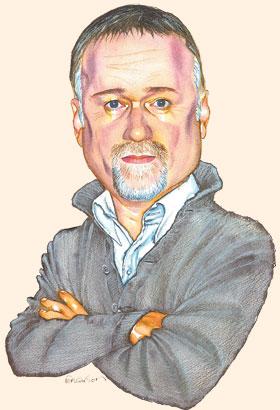
It is unclear whether this unsettling early experience explains the dark, murderous themes that recur in the films Fincher has directed, from Se7en (1995), via Fight Club (1999) and The Social Network (2010) to The Girl with the Dragon Tattoo (2011) – though its influence on Zodiac (2007) is obvious. “It may have been when I first became aware of this notion of the aberrant thinker, thinning the herd,” he says with a wry smile, shortly after we meet in Off the Record, the basement bar and restaurant in the Hay-Adams hotel in Washington, DC.
There is darkness aplenty in his latest work, a 13-episode adaptation for Netflix, a subscription video service, of the 1990 hit BBC series House of Cards. Fincher’s version stars Kevin Spacey as a Machiavellian politician in a role first made famous by the late Ian Richardson. The action has been transposed from London to Washington, names have been changed – Spacey is Francis Underwood, rather than Urquhart – and the politics are American, not English. But the central theme of House of Cards is the same: spurned by his leader after being promised a more senior role, Underwood embarks on a relentless and ruthless quest for revenge.
With this in mind, we are eating in a fitting venue: short of dining in the West Wing staff canteen, it would be difficult to be any closer to the White House. Built in 1927, the Hay-Adams is a stone’s throw from the seat of political power and its basement bar is a favoured hang-out of journalists, lobbyists and members of Congress. Its walls are hung with framed caricatures of leading political figures: one has a studious Barack Obama mimicking Rodin’s “The Thinker”; in another a perfectly coiffed Mitt Romney looks admiringly in a hand-mirror only to see Paul Ryan staring back at him.
Fincher, wearing jeans, a grey cardigan and dark open-necked shirt, has arrived before me and is nursing a ginger ale. He has flown in from California for the glitzy Washington launch of the series in a few hours, when various political bigwigs will see the first two episodes of the show. He stifles a yawn. “I only had two hours’ sleep last night,” he says, explaining that he was up late working on a video. “So there’s a chance I might be interesting.”
A waiter in a waistcoat appears at our table and we study the menu. Fincher demurs when I ask if he will have a glass of wine, saying he has a headache. I happen to have some paracetamol with me and offer him one, which he accepts. He orders a Cobb salad “but without the blue cheese”; I choose steak salad and mineral water, and the waiter glides away.
Fincher, 50, says he didn’t have a burning interest in politics before making House of Cards but was fascinated with the original, particularly the breaking of the so-called narrative “fourth wall”, whereby Urquhart directly addresses the audience, involving it in his conspiracies. “I loved the idea of lessons with Machiavelli. That’s what I loved about Ian Richardson. He was wry and had great wit in the way that he skewered people.”
He puts the conceit to good use with Spacey who, in the southern drawl of a congressman from South Carolina, confides to the camera while walking through a crowded ballroom; he whispers asides while other characters are talking to him, and punctuates a dull conversation with two bores with an arched eyebrow and a snap of a salt dispenser that sounds like a gunshot.
Fincher is a demanding director, with a reputation in Hollywood for meticulous attention to detail and willingness to shoot take after take – often, to the chagrin of his actors – until he gets the shot or performance that he wants. This does not deter them from returning for more: he works with a tight-knit circle of writers and actors and has made three films with Brad Pitt (this is his second project with Spacey). He clearly got what he wanted from Spacey, who delivers one of his best performances in years. “Like taking candy from babies,” Fincher says of Spacey’s suitability for the role. “When I first read the script I thought: if not him, who could do this? There’s no one else.”
As is the way with Hollywood-helmed TV series, Fincher, who is also the executive producer of House of Cards, directed the first two episodes and chose the directors for the remaining nine, who have maintained the look and pace of the show, which shares the shadows and muted colour palette of Fincher’s earlier work. Why the departure from film? “I wanted to try to do something in TV. It’s not exactly TV,” he says, acknowledging that only Netflix and its subscribers will be able to watch the series (the company bought the series for an estimated $100m from Media Rights Capital, which negotiated with Michael Dobbs, the Conservative politician who wrote the original). “Well, the form of it is like TV. It’s episodic. We call it … ” He pauses, cracking another smile worthy of Spacey’s Underwood, “ ‘streaming episodic content’.”
Netflix is making all 13 episodes available at once – they were simultaneously released in the 40 countries the company operates in on Friday. Won’t releasing all the episodes spoil the tension? “I’m all for it.” Viewers have got used to binge-viewing TV shows, he says: he discovered Breaking Bad, the acclaimed series about a New Mexico chemistry teacher who becomes a drugs kingpin, that way.
The salads arrive and we start eating, Fincher pinching an endive leaf and using it to scoop up chunks of tomato. He says the post-production process is radically different from anything he was used to. “It’s been exhausting. If you’re making a show that’s available to viewers on the same day … you have to experience it in the way that they might.” That meant [at least once] watching all 13 hours at one sitting.
The son of a journalist and nurse, Fincher says his interest in film was sparked by his father taking him as a small boy to see a re-release of Alfred Hitchcock’s Rear Window. “I was eight, maybe 10 years old. I knew The Birds and Psycho but I didn’t know The Lady Vanishes or Rebecca. I knew Universal Studios-era Hitchcock … ” In Rear Window, Jimmy Stewart’s wheelchair-bound LB “Jeff” Jeffries suspects that his neighbour Lars Thorwald (Raymond Burr) has been up to no good. “I’m watching it with my dad and seeing Lars Thorwald go out in the middle of the night with a giant suitcase. I remember watching this scene and turning to my dad and whispering, ‘He cut her up and put her in the suitcase.’
“The notion that someone would solve a problem by butchering their spouse was completely outside any realm of experience that I had. And yet I had been taken by the tide and was experiencing that shocking, fantastic thing that happens when a movie works. When you go … ” He takes a deep breath: “Ohhhhhh.”
He once told another interviewer that he didn’t know how much movies should entertain: he was more interested in movies that scar. “I was talking about Se7en,” he explains. The unconventional ending to Se7en, in which – spoiler alert – one of the characters discovers the head of his murdered, pregnant wife in a box, is one of the more brutal and devastating finales in cinema – and was initially resisted by the studio that released the movie. But Fincher held his ground. “I’m sure Rear Window affected in some way what I liked about reading the Se7en script,” he says. “One of the things that most interested me is that I know how many pages are in it because I’m holding it, and I know there are 15 pages left. John Doe comes in and gives himself up and he’s covered in blood. And I’m thinking: how do you resolve this? This can’t happen. In terms of the structure and in terms of the anxiety that provokes in the audience … all bets are off. It’s literally not what [the audience] signed up for. You’re supposed to behave in a certain way.”
. . .
Though Fincher’s childhood experience of Rear Window convinced him that he wanted to work in Hollywood, there was already plenty of film-making taking place around him in Marin County. He grew up in a middle-class family but their neighbours were some of Hollywood’s biggest names. “George Lucas was my neighbour, Francis Coppola was shooting The Godfather [nearby] in Shady Lane. There was a lot of film around.”
Lucas, who had not yet made Star Wars, was then embarking on his film career. “I was walking down the street one day with a friend of mine and saw a crew setting up lights for American Graffiti. We saw these old [Ford] Thunderbirds driving around. And then the movie came out. They found a part of a street in Petaluma that looked 10 years old and were able to transport an audience back in time with wardrobe, the hairstyles. To see that happen … was unbelievable.” And fortunate, I say. Imagine if he had been raised in Idaho instead of Marin County. “I’d be a rancher. I’d be delivering calves now.”
When he was 14 his parents moved to Oregon but three years later the 17-year-old Fincher returned to California, where he stayed with a friend and his mother, and, unusually for a film director of his generation, did not attend film school. Within two years, however, he had found himself a job working for Lucas’s Industrial Light and Magic, where he was part of the crew that made Return of the Jedi (1983).
We have demolished our salads and the waiter is hovering. I look hopefully at the menu again and ask if Fincher will join me for a glass of wine. The paracetamol seems to have worked. “You know what, I’m going to drink heavily this evening so I will get something kind of light,” he says. He settles on a glass of Pinot Grigio and an espresso; I choose a glass of Viognier.
I ask him how he went from a production job into directing at such a young age. “I thought about going to college. I was a cliché … I wanted to be Steven Spielberg or George Lucas. I wanted to go to USC [the University of Southern California] but I was never a very good student and didn’t have the grades to get in.”
His practical experience seemed to work, though. After his job at ILM he moved to Los Angeles where a new industry – music videos – had been created, seemingly overnight. Fincher’s early training helped. “In grade school and middle school, they had film classes. And I took them all. At the beginning of every year they would give you a 45[rpm] single and you would have to make a film to it. By 1981, I’m sitting around my apartment and all of a sudden there’s this thing called MTV. And when I saw MTV I thought: ‘I actually know how to do this. I know how to produce something that is four minutes long.’ Doing my first couple people kept asking me: ‘What makes you think you can do this?’ And I said, ‘Well. I’ve been doing this for 10 years.’ ”
He further honed his craft making commercials for brands such as Nike, Adidas and Budweiser, as well as music videos for a range of acts, among them Nine Inch Nails, the Rolling Stones and Madonna (he directed her videos for “Vogue” and “Express Yourself”). In the halcyon days of music video he was a dominant force: in 1990 he received three of the four nominations in the best director category at the MTV Awards. After that, he went on to features and although he had a miserable experience making Alien 3 (1992) – the studio meddled and he could not get the light or colours that he wanted – he has not looked back. “I could not get the screen to be black,” he recalls. “I couldn’t get the creature to come out of the shadows unseen.”
It’s an obstacle he overcame years ago, creating a unique visual style that is as present in House of Cards, where the malevolent Underwood is often cloaked in darkness, as it is in his other work.
An executive has come to collect him but before he leaves I want to know how he has managed to make films that are so often unsettling within the rigid constraints of the Hollywood studio system. “What the studios are doing is having a diversified portfolio. They’re going to do some stuff that’s going to get some high-fives for its weekend grosses. And they’re going to do some stuff to get you some nods from the Golden Globes.”
Fincher’s films have made money, grossing $1.77bn worldwide, according to BoxOfficeMojo, which tracks box office performance. They have also earned critical acclaim: Fincher won the Golden Globe for The Social Network in 2011, a movie most critics expected to scoop the best picture Oscar at the Academy Awards (it lost out to The King’s Speech). “No movie is made with the intention of losing money. The ones that are good are as much a by-product of luck as they are of effort. It takes a lot of things coming together, you know? You’re running around a field with a jar trying to catch lightning.” He gets up to leave; I tell him to enjoy the screening. “Yes, the huge event,” he deadpans. “As a special treat we’re going to show you all 13 hours.”
There is a lot riding on House of Cards. It is the most expensive internet series ever produced and for Netflix it is a big bet that audiences are embracing a new way to judge drama, choosing online viewing over traditional TV.
Judging by the early critical response, Netflix and Fincher have a hit on their hands. Later, I see him at the after-party. Michael Dobbs, who wrote the original BBC series is there, as are Kevin Spacey, Robin Wright and the other stars of Fincher’s version, fending off well-wishers and mingling with Washington politicos. And there is Fincher, now changed into a sharp suit, Hollywood’s own dark prince, holding court.
(I acknowledge selections from multiple sources for this blog)
